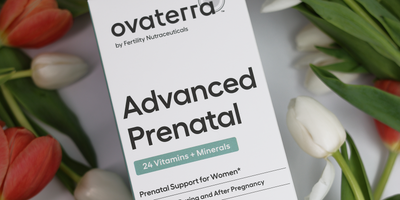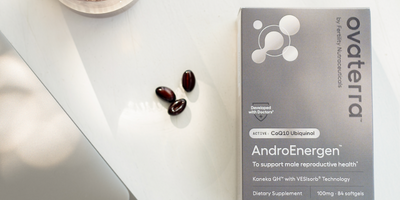Vitamin D, a fat-soluble vitamin involved in multiple biological processes in the body, has been suggested as an important nutrient during the preconception and prenatal period. Known as the “sunshine vitamin,” Vitamin D is synthesized in the skin when exposed to the UV rays of the sun. Vitamin D is probably best known as the facilitator of bone health, working hand in hand with Vitamin K and Calcium.
Why is Vitamin D important for reproductive health?
Though less well known, Vitamin D also plays important roles in reproductive and prenatal health. A healthy level of Vitamin D has been variously linked to normal AMH levels (which suggest normal ovarian reserve), regular ovulation, healthy endometrium and sufficient luteal phase length to support implantation.
During pregnancy, Vitamin D is crucial for the development of the baby’s skeletal system, and to protect the mom’s bones and teeth. Studies have also suggested that adequate levels may help support multiple aspects of maternal and fetal health.
More: Watch this video to learn from Dr. Bruce Hollis about Vitamin D and reproductive health.
What’s a healthy level of Vitamin D?
All this may make you wonder: What’s a good level of Vitamin D for reproductive and prenatal health? Vitamin D levels are measured as levels of 25-hydroxyvitamin D, or 25(OH)D, in the blood. Doctors have different recommendations for 25(OH)D:
- NASEM defining 20 ng/mL as generally adequate for bone and general health.
- The Endocrine Society recommends at least 30 ng/mL.
- Some Vitamin D experts recommend even higher levels, in the 40-60 ng/mL range.
Specifically for reproductive health, Dr. Bruce Hollis, a Vitamin D expert with lifelong career focused on Vitamin D and prenatal health, recommends at least 40 ng/mL.
Who are at risk of low Vitamin D levels?
We synthesize a majority of our Vitamin D in our skin, when exposed to UV rays from the sun. In summer, just 5-30 minutes in the sun several times a week should be enough for most people to generate enough Vitamin D. Yet, inadequate levels of Vitamin D are surprisingly common.
In the United States, studies estimate that 5% of the population are extremely low on Vitamin D (defined as under 12 ng/mL, so, very low compared to the 40 ng/mL recommended for reproductive health), while about a quarter have less than 20 ng/mL. Some estimates peg the US Vitamin D deficiency rate at a surprisingly high 41%.
The important thing is that low Vitamin D levels are significantly more common among some groups than others. Here are some groups who are at risk of low Vitamin D levels, and why:
- Age: As we age, the skin becomes less efficient at producing Vitamin D from sun exposure.
- Skin color: People with darker skin are more likely to be low on Vitamin D, because the melanin reduces the skin’s ability to synthesize Vitamin D. For example, scientists believe that a majority of African Americans have insufficient levels of Vitamin D.
- Climate: People who live further away from the equator are more likely to have low Vitamin D levels, especially in winter.
- Sun exposure: People who don’t spend much time outdoors during the day, or those who are more careful about sun protection for skin health, can be at a higher risk of Vitamin D insufficiency.
- Medications and health conditions: Some medications and health conditions, especially those that affect absorption of fat, can make it difficult for the body to absorb and use Vitamin D. The list here includes inflammatory bowel disease, cystic fibrosis, gastric bypass surgery and others.
- Obesity: Because fat cells can hold onto more Vitamin D and reduce the amount that circulates in the blood, people with obesity can have less Vitamin D that the body can use.
How to know if a Vitamin D supplement is for you
There are some foods high in Vitamin D like salmon, sardines and white mushrooms that you can add to your diet to bolster your Vitamin D levels. A Vitamin D supplement is also an option to maintain healthy levels – but how do you know if a Vitamin D supplement is right for you?
Signs of low Vitamin D
You may suspect that you may be low on Vitamin D with some signs of inadequate Vitamin D levels:
- Fatigue
- Bone pain
- Muscle weakness and cramps
- Changes in mood, like depression
However, symptoms of low Vitamin D levels are not very distinct in adults, and many people with low Vitamin D don’t have any noticeable symptoms. So, they are not a reliable way to tell if you are low in Vitamin D.
Vitamin D tests
A more reliable way to decide if Vitamin D supplements may be right for you is to take a Vitamin D test. A simple blood test – either done at your doctor’s office or at home using an at-home Vitamin D test kit – is all it takes for you to know if your Vitamin D levels are adequate to support your reproductive health.
If you test your Vitamin D levels at your doctor’s office, ask for a 25(OH)D test. Whether done with your doctor or at home with a kit, the level to look for is 40 ng/mL (or about 100 mol/L). If your Vitamin D is below that threshold, and lifestyle modifications like spending more time in the sun and eating more salmon are challenging, a supplement may be a good option for you.
How to choose a Vitamin D supplement
There are a ton of Vitamin D supplements on the market. How do you know which Vitamin D supplements are good choices? According to Dr. Hollis, there are several things to pay attention to.
- Oil-based liquid formula: To deliver this fat-soluble vitamin into the cells, it’s best to select a brand that uses oil-based liquid formula. It can be an oil-based softgel, but a liquid formula makes it easier to choose a dose that’s right for your current Vitamin D levels, too.
- Form of Vitamin D: There are two major forms of Vitamin D, and you want the brand with D3. This is the form of Vitamin D our skin synthesizes naturally.
- Vitamin K2: Some higher-quality Vitamin D supplements include Vitamin K2, another nutrient that works with Vitamin D to support healthy bone metabolism.
For more information on how to choose your Vitamin D, read our Vitamin D supplement guide.
How do you know the Vitamin D supplement is working?
When you are on Vitamin D supplement, you may want to repeat your Vitamin D test to see how the levels have changed. It’s a good idea to consult your doctor to determine if your current dose is the right dose, based on the new test results. Some doctors like to start on a high dose and move to a lower, “maintenance” dose once you have a healthy Vitamin D level.
Other ways to get more Vitamin D
Of course, there are other ways to boost your Vitamin D levels, primarily through lifestyle changes. The top two are:
- Spend more time in the sun: It depends on multiple factors, but doctors estimate 5-30 minutes several times a week may be enough for many people.
- Eat Vitamin D-rich foods with fat: Aim for 600 IU of Vitamin D in your diet. A 3-oz portion of salmon almost gets you there, while 1 cup of milk fortified with Vitamin D gets you 1/5 of the way.
Please reach out if we can answer any questions about Vitamin D supplements during your preconception and prenatal periods. We are with you.












